|
|
|
Sort Order |
|
|
|
Items / Page
|
|
|
|
|
|
|
| Srl | Item |
| 1 |
ID:
176834
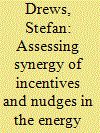

|
|
|
|
|
| Summary/Abstract |
Should policy-makers combine price incentives with behavioural nudges to encourage sustainable energy behaviour? Available evidence from various behavioural sciences is scarce and inconclusive about synergy of the two instruments. This is partly due to methodological limitations. We offer a framework to overcome such limitations in future research and to guide policy-making. It includes four cases: no synergy, positive synergy, weak negative synergy, and strong negative synergy or backfire. The adoption of a policy mix is recommended in the first two cases, and may be pursued in the third case. To clarify the underlying mechanisms of the synergy, a distinction is made between crowding (in/out) of intrinsic motivations by incentives and crowding (in/out) of extrinsic motivations by nudges. This distinction turns out to be especially relevant in the case of weakly negative synergy, as here behavioural and temporal spillover effects require consideration from the policy-maker as well. We end with broader reflections regarding other policy criteria for the design of an adequate energy policy mix.
|
|
|
|
|
|
|
|
|
|
|
|
|
|
|
|
| 2 |
ID:
103465
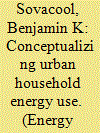

|
|
|
|
|
| Publication |
2011.
|
| Summary/Abstract |
This article begins by defining energy services and identifying how they differ according to sector, urban and rural areas, and direct and indirect uses. It then investigates household energy services divided into three classes: lower income, middle income, and upper income. It finds that the primary energy technologies involved with low-income households involve a greater number of fuels and carriers, ranging from dung and fuelwood to liquefied petroleum gas and charcoal, but a fewer number of services. Middle-income households throughout the world tend to rely on electricity and natural gas, followed by coal, liquefied petroleum gas, and kerosene. These homes utilize energy to produce a much broader range services. The upper class or rich have access to the same energy fuels, carriers, and technologies as middle-income homes and families, but consume more energy (and more high luxury items). The study highlights how focusing on energy services reorients the direction of energy policy interventions, that energy services are neither uniform nor innate, and by noting exciting areas of potential research.
|
|
|
|
|
|
|
|
|
|
|
|
|
|
|
|
| 3 |
ID:
059756


|
|
|
| 4 |
ID:
116973
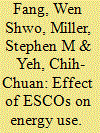

|
|
|
|
|
| Publication |
2012.
|
| Summary/Abstract |
Energy saving can importantly help prevent greenhouse gas emissions and, thus, climate change. Energy service companies (ESCOs) provide a crucial instrument for delivering improved energy efficiency and potentially contributing to substantial energy savings in the public and private sectors. This paper investigates empirically the effect of ESCO activities on energy use. Based on a dynamic IPAT model, using a panel data of 94 countries over the period 1981 to 2007, we provide significant evidence that ESCOs reduce energy use. This finding proves robust to different dates of the first ESCO. The negative ESCO effect increases over time. The dynamic adjustment process produces small effects in the short run, but large effects in the long run. Moreover, the long-run ESCO effect differs across the stages of development. That is, for the high- and low-income countries, the short-run ESCO effect remains negative, but the long-run effects differ, remaining negative in high-income countries, but becoming positive in low-income countries. Finally, we discuss energy policy implications.
|
|
|
|
|
|
|
|
|
|
|
|
|
|
|
|
| 5 |
ID:
115152
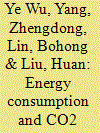

|
|
|
|
|
| Publication |
2012.
|
| Summary/Abstract |
Vehicle electrification has been seriously considered as an industry revolution to achieve sustainable transportation in China. Hybrid electric vehicles (HEV), plug-in hybrid electric vehicles (PHEV) and pure electric vehicles (EV) are being demonstrated in scores of large cities. We select three well-developed regions (Jing-Jin-Ji, Yangtze-River-Delta and Pearl-River-Delta) to explore regional growth patterns for the light-duty passenger vehicle fleet and develop various scenarios for the penetration of HEV, PHEV and EV during 2010-2030. Per-kilometre and fleet well-to-wheels (WTW) petroleum use, fossil energy and CO2 emissions are evaluated among various technology options. Promotion of PHEV and EV could help cut per-kilometre petroleum use to a great extent; however, to achieve a clear reduction benefit in oil demand for a fleet in three regions takes time. The effort to mitigate CO2 emissions is much more difficult than lowering fossil energy use or oil consumption. This is especially true for the Jing-Jin-Ji Region where coal is an overwhelming power source. In those regions with a high share of coal power, HEV is a better option than PHEV or EV to reduce WTW CO2 emissions. In the Pearl-River-Delta region with a much cleaner electricity mix, promotion of EV could achieve a more significant CO2 reduction.
|
|
|
|
|
|
|
|
|
|
|
|
|
|
|
|
| 6 |
ID:
097274


|
|
|
|
|
| Publication |
2010.
|
| Summary/Abstract |
This paper examines household energy use and appliance ownership in Ireland. Logit regression analyses on a large micro-dataset reveal how household characteristics can help explain the ownership of energy using appliances. Using OLS regression models, we explore the factors affecting residential energy demand conditional on appliance ownership. Results suggest that the methods of space and water heating employed by a household are even more important than electrical appliances in explaining domestic energy usage. However, the stock of appliances must be included in such models so that results will not be biased. The methods employed in this paper can be easily adopted for studies of household energy use in other countries where household expenditure survey data are available.
|
|
|
|
|
|
|
|
|
|
|
|
|
|
|
|
| 7 |
ID:
169890
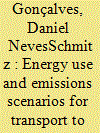

|
|
|
|
|
| Summary/Abstract |
To achieve the mitigation targets discussed under the Paris Agreement, countries must develop studies that not only estimate baselines based on historical data of greenhouse gas (GHG) emissions and energy use, but that also project them considering different levels of ambition and political commitment. This study aims to develop and model scenarios of energy use and GHG emissions from the transport sector until 2030, considering the Brazilian Nationally Determined Contribution (NDC). Three scenarios were developed based on different political commitment. The method is based on a bottom-up approach, requiring multi-sectoral collaborative efforts to not only explain the direct energy use, but also balance the transportation activity and energy between the transport modes, justifying each case in terms of development stage and energy supply capacity. Here, transport sector has been further split up into the highest sector level detail available. At the maximum, GHG emissions could be reduced by 15% (29 Mt CO2e), achieved in scenario 3, whilst there are increases on emissions in scenario 2 (5% or 10 Mt CO2e) and scenario 1 (21% or 42 Mt CO2e). It implies that Brazil has the potential to ratchet up the mitigation targets discussed under the Paris Agreement of the UNFCCC.
|
|
|
|
|
|
|
|
|
|
|
|
|
|
|
|
| 8 |
ID:
057323
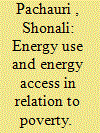

|
|
|
| 9 |
ID:
166298
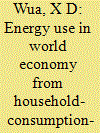

|
|
|
|
|
| Summary/Abstract |
An overview for energy use within the world economy as reflected by the Eora database for 2012 is conducted by means of household-consumption-based multi-regional input-output analysis that is parallel to existing energy accounting frameworks. From a household-consumption-based perspective, the energy use for Mainland China economy is only around half of that for the United States. The world's trade volume of energy use associated with consumer products is quantified, which is over one-fifth of the global total energy consumption. Mainland China is revealed to be with the largest trade deficit of energy use, in magnitude up to the summation of the trade imbalance of all other major economies. Heavy industry products shipped to Europe & Eurasia, Asia Pacific and North America account for nearly 80% of Mainland China's exports of energy use. To safeguard sustainable energy use, the developed economies are suggested to further strengthen their comparative advantages in those high value-added goods or services while developing economies such as Mainland China are supposed to alter the trade patterns by a transition of economic structure.
|
|
|
|
|
|
|
|
|
|
|
|
|
|
|
|
| 10 |
ID:
121383


|
|
|
|
|
| Publication |
2013.
|
| Summary/Abstract |
This paper aims to investigate the relationship between energy use-GDP, energy use-exports-trade and energy use-imports on aggregate level in the OECD countries. While the energy use-growth nexus is widely examined in the literature, studies on the energy use-trade nexus are very scarce. Thus, this study also serves to fill this gap by presenting a new research on the OECD countries. We employ the panel cointegration technique and use the Granger representation theorem to examine the presence of long-run relationship and the causality between pairs of variables. To investigate the presence of causality, several tests developed by Canning and Pedroni (2008) are used. We find that the pairs of energy use-GDP, energy use-exports and energy use-imports are cointegrated and there is two-way Granger causality between each pairs. We also estimate the long-run elasticities by employing panel dynamic ordinary least squares. The results suggest that the sign of long-run elasticity is positive for all pairs. Particularly, 1% increase in GDP, export and import causes almost 0.32%, 0.21% and 0.16% increase in energy use respectively.
|
|
|
|
|
|
|
|
|
|
|
|
|
|
|
|
| 11 |
ID:
125660
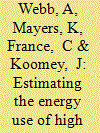

|
|
|
|
|
| Publication |
2013.
|
| Summary/Abstract |
As the energy use of games consoles has risen, due to increased ownership and use and improved performance and functionality, various governments have shown an interest in ways to improve their energy efficiency. Estimates of console energy use vary widely between 32 and 500 kWh/year. Most such estimates are unreliable as they are based on incorrect assumptions and unrepresentative data.
To address the shortcomings of existing estimates of console energy use, this study collates, normalises and analyses available data for power consumption and usage. The results show that the average energy use of high definition games consoles (sold between 2005 and 2011 inclusive) can be estimated at 102 kWh/year, and 64 kWh/year for new console models on sale in early 2012. The calculations herein provide representative estimates of console energy use during this period, including a breakdown of the relative contribution of different usage modes.
These results could be used as a baseline to evaluate the potential energy savings from efficiency improvements in games consoles, and also to assess the potential effectiveness of any proposed energy efficiency standards. Use of accurate data will help ensure the implementation of the most effective efficiency policies and standards.
|
|
|
|
|
|
|
|
|
|
|
|
|
|
|
|
| 12 |
ID:
104908


|
|
|
|
|
| Publication |
2011.
|
| Summary/Abstract |
In this work, an analysis is being done on the concept of energy and exergy utilization and an application to the residential and industrial sector of Greece. The energy and exergy flows over the period from 1990 to 2004 were taken into consideration. This period was chosen based on the data reliability. The energy and exergy efficiencies are calculated for the residential and industrial sectors and compared to the findings of a previous study concerning the exergy efficiency of the Greek transport sector. The residential energy and exergy efficiencies for the year 2003 were 22.36% and 20.92%, respectively, whereas the industrial energy and exergy efficiencies for the same year were 53.72% and 51.34%, respectively. The analysis of energy and exergy utilization determines the efficiency of the economy as a whole. The results can play an important role in the establishment of efficiency standards of the energy use in various economy sectors. These standards could be utilized by energy policy makers.
|
|
|
|
|
|
|
|
|
|
|
|
|
|
|
|
| 13 |
ID:
133142


|
|
|
|
|
| Publication |
2014.
|
| Summary/Abstract |
In this paper, we identify key drivers and barriers for the adoption of building energy retrofits in Germany, which is promoted by public policy as an important measure to address the future challenges of climate change and energy security. We analyze data from a 2009 survey of more than 400 owner-occupiers of single-family detached, semidetached, and row houses in Germany, that was conducted as a computer-assisted personal interview (CAPI). In the survey, respondents were asked directly for reasons for and against retrofitting their homes, but also faced a choice experiment involving different energy retrofit measures. Overall, we find that house owners who are able to afford it financially, for whom it is profitable, and for whom there is a favorable opportunity are more likely to undertake energy retrofit activities. The latter point seems to be of particular importance in explaining the persistent low retrofit rate in Germany. Our results suggest that professional energy advice could stimulate the demand for building energy retrofits.
|
|
|
|
|
|
|
|
|
|
|
|
|
|
|
|
| 14 |
ID:
099214


|
|
|
|
|
| Publication |
2010.
|
| Summary/Abstract |
Improved energy efficiency is a key policy goal of all International Energy Agency (IEA) member countries, but tracking energy efficiency gains is not straightforward. As part of its contribution to the G8 Gleneagles Plan of Action, the IEA has been developing in-depth indicators-tools that provide data and analysis of energy use and efficiency trends. This paper gives an overview of the IEA indicator methodology and presents examples of how disaggregated indicators can be used to identify the factors that drive and restrain energy demand at the end-use level. A decomposition approach is also used to separate efficiency effects from the impacts of structure and activity. The results clearly show the important role that energy efficiency has played in shaping trends in final energy use in IEA countries for more than 30 years. However, the analysis also reveals that recent gains in energy efficiency have been much lower than in earlier decades. Accelerating energy efficiency improvements is therefore a crucial challenge for IEA governments and indicators have an important role to play in helping to develop and evaluate the policies that will be required.
|
|
|
|
|
|
|
|
|
|
|
|
|
|
|
|
| 15 |
ID:
133177


|
|
|
|
|
| Publication |
2014.
|
| Summary/Abstract |
The increasing demand for renewable energy drives the development of offshore wind energy (OWE) leading to competing claims with other human and nature related uses of the North Sea. This paper investigates possibilities to identify space for new OWE while minimising effects on other uses. An inventory is made of the major uses in the Central and Southern North Sea, including the expected development towards 2030. The spatial distribution of non-wind uses is determined as well as the possibilities for differentiation based on density, economic value or nature value and co-existence. These possibilities are translated into calculation rules quantifying the relative importance. These calculation rules have been incorporated in a Decision Support System (DSS) to analyse how the priority of OWE development could impact non-wind uses. In a low OWE priority scenario consequences for other use was found to be very limited, with fisheries and wildlife affected most. In a high OWE priority scenario a considerable amount of OWE may be developed with substantial claims on sand extraction and military use areas and a shift towards higher value categories for shipping and fisheries. Relocation and co-existence of uses are important means to reduce the impact of increased OWE development.
|
|
|
|
|
|
|
|
|
|
|
|
|
|
|
|
| 16 |
ID:
133224


|
|
|
|
|
| Publication |
2014.
|
| Summary/Abstract |
Using panel data of 24 countries in the Middle East and North African (MENA) region from 2001 to 2009, the purpose of this study is to examine the impacts of tourism, energy consumption and political instability on economic growth within the neoclassical growth framework. To address the objective of this study, we utilise both the static panel data approach as well as the dynamic generalised method of moments (GMM) estimator to examine the impact of candidate variables. Our results show that energy consumption and tourism significantly contribute to the economic growth of countries in the MENA region. Hence, our study lends some support to the existence of the tourism-led growth and energy-led growth hypotheses in the region. In line with our expectation, our estimation results also reveal that political instability impedes the process of economic growth and development in the MENA region. Therefore, macroeconomic policies to promote expansion in tourism and energy consumption will directly stimulate economic growth. Additionally, efforts to help the region overcome its history of political instability would attract more international tourist arrivals and further invigorate economic growth.
|
|
|
|
|
|
|
|
|
|
|
|
|
|
|
|
| 17 |
ID:
167002
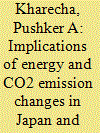

|
|
|
|
|
| Summary/Abstract |
Following the March 2011 nuclear power plant accident in Fukushima, Japan, nuclear power production declined sharply in that country as well as Germany. Despite widespread media coverage of CO2 emission increases in the first few years afterward, subsequent energy and emission changes and their implications are not well-studied. Here we analyze energy, electricity, and CO2 emissions data for both countries through 2017. We also quantify the human health and CO2 implications of two simple yet illuminating scenarios: What if both countries had reduced fossil fuel power output instead of nuclear? And what if the US and the rest of Europe eliminate their remaining nuclear power? We find that emissions increased after Fukushima until 2013 but decreased thereafter due to record-high renewable energy production and lower total energy use. However our “what if” scenarios demonstrate that these two countries could have prevented 28,000 air pollution-induced deaths and 2400 MtCO2 emissions between 2011 and 2017. Germany can still prevent 16,000 deaths and 1100 MtCO2 emissions by 2035 by reducing coal instead of eliminating nuclear as planned. If the US and the rest of Europe follow Germany's example they could lose the chance to prevent over 200,000 deaths and 14,000 MtCO2 emissions by 2035.
|
|
|
|
|
|
|
|
|
|
|
|
|
|
|
|
| 18 |
ID:
104937
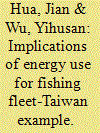

|
|
|
|
|
| Publication |
2011.
|
| Summary/Abstract |
Commercial fisheries rely heavily on fossil fuel combustion and contribute heavily to the emission of atmospheric pollutants and greenhouse gases. Propulsion output of fishing vessels has continually increased from 30 kW in 1959 to nearly 320 kW in 2000, indicating that the Taiwanese fishing fleet tended to voyage farther and faster, and to adjust for the heavier loads demanded by more powerful fishing gear. Daily emissions from Taiwanese fishing vessels were estimated using output method. The marine fishery is unlikely to grow in the future as the government is implementing measures to ensure the development of sustainable fishing practices. There has been a rising trend in pollution to production ratios during the study period between 1959 and 2008. The ratio increased by 47% in the first decade, followed by fluctuations within the range of 50%-58% for the remainder of the statistical period. There is a need to investigate the possibility of reductions in all categories of fishing with regard to energy use and emissions through the subsidization of fishing vessels to encourage operators to switch to more energy efficient equipment and cleaner fuels.
|
|
|
|
|
|
|
|
|
|
|
|
|
|
|
|
| 19 |
ID:
169866
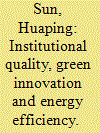

|
|
|
|
|
| Summary/Abstract |
This paper examines the energy efficiency performance of a sample of 71 developed and developing countries between 1990 and 2014. In most current energy literature, the transition to green technology is seen as a sustainable way to achieve a low-carbon or carbon-free environment. Bearing this in mind, we argue further that adopting green technology needs a strong backing and funding of reliable government institutions to shift the country's paradigm. Considering this issue, we adopt the parametric stochastic frontier approach built on the shepherd distance function to evaluate the effects of both governmental institutions and green technologies on energy efficiency. We find evidence of a significant positive influence of both green innovation and institutional quality on energy efficiency enhancement having controlled for some variables. Regarding energy efficiency levels of the individual countries- USA, Japan, Germany and Australia lead the chart while Belize, Panama, Singapore, Malta, Sierra Leone, Iceland, Jamaica, Bahrain and Ghana are the least energy efficient countries. Policy implications are further discussed.
|
|
|
|
|
|
|
|
|
|
|
|
|
|
|
|
| 20 |
ID:
094868


|
|
|
|
|
| Publication |
2010.
|
| Summary/Abstract |
Since the adoption and implementation of new technologies has an important influence on the structure and performance of the economy in both developed and developing countries, many research papers are devoted to the technology-economy nexus. Motivated by the fact that the impact of technical progress on the demand for different production factors may vary depending on the bias of the technological change, in this paper, by estimating a translog cost-share system and using state-space modeling technique, we investigate to what extent the direction of technical change is biased toward energy and away from other factors. By applying this methodology to the French economy for the period 1978-2006 the obtained results suggest that: first, technical change has a non-neutral impact on factor demands; second, capital-saving technical progress is present in the majority of the sectors studied; third, energy demand has increased in all sectors but electricity and gas. These findings may have important policy implications for environmental and energy issues in France.
|
|
|
|
|
|
|
|
|
|
|
|
|
|
|
|
|
|
|
|
|